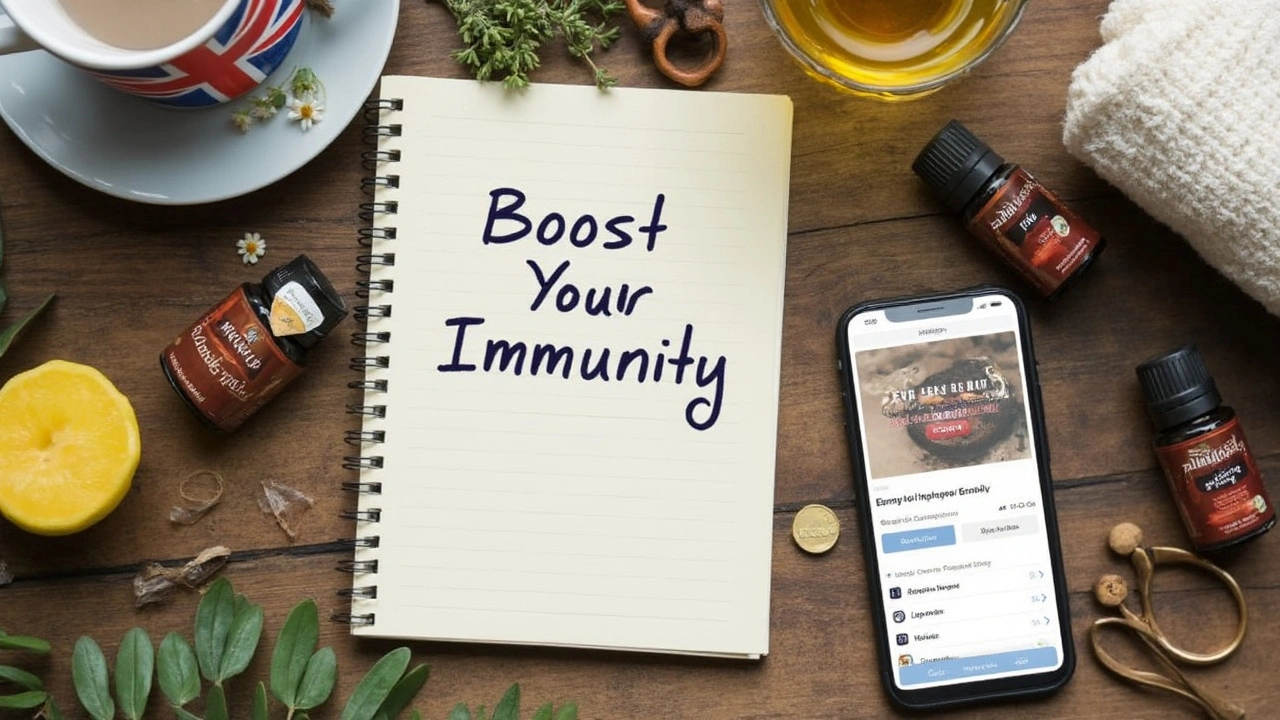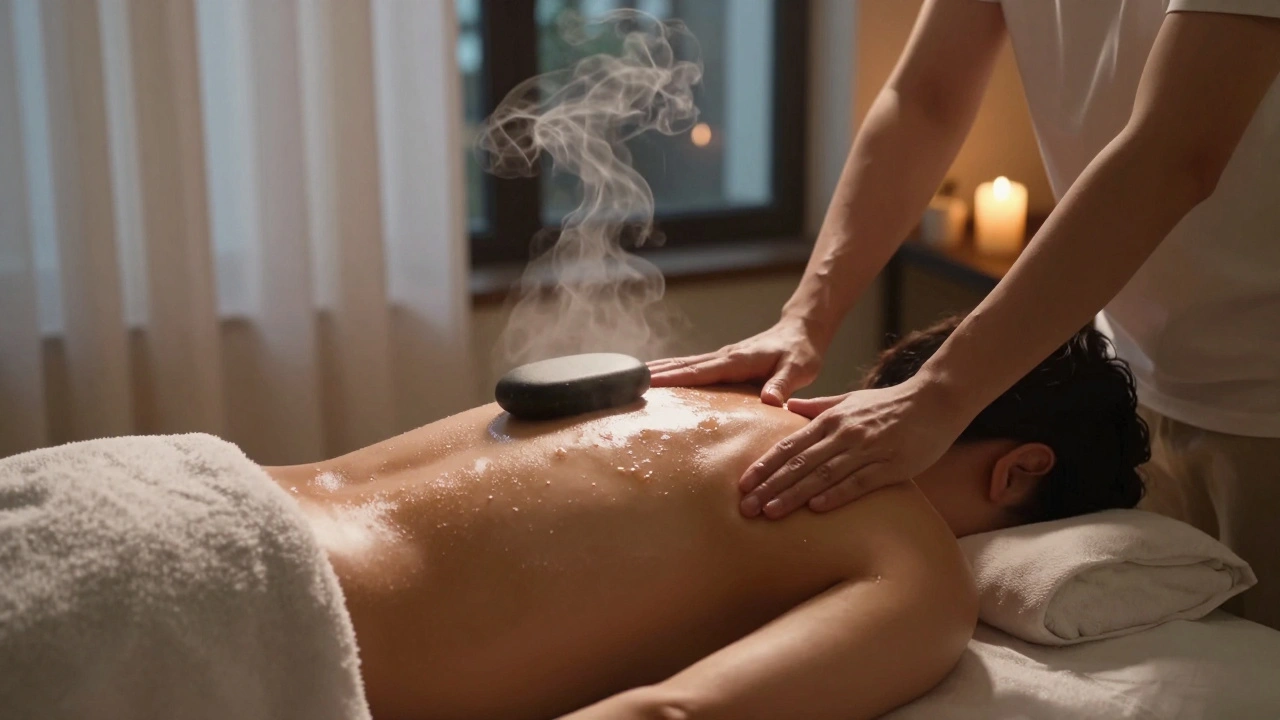Body massage isn't just for sore muscles-it's a proven way to clear mental fog, reduce stress, and improve focus. Discover how regular sessions can reset your mind and boost clarity in just 60 minutes.

- Created by: Elara Wainwright
- Completed on: 11 Jun 2025
- Categories: Body Massage
Think massage is just for stiff shoulders or sore backs? Turns out, there’s more under the surface—getting a massage can actually nudge your immune system into working better. Imagine coming out of a session not just feeling chill, but knowing your body’s got your back all week.
It’s not some old wives’ tale either. When a pro works those muscles, stress hormones drop, blood movers (hello, white blood cells!) speed up, and your body gets in the mood to fight off unwanted invaders. There’s actual science showing regular massage lowers stress and ramps up your immune defenders. So, if you want something that feels good and does good, body massage makes a strong case.
Ever noticed how you pick up fewer colds when you’re less stressed? Stress zaps immunity, and massage is a shortcut to switching down your stress meter. If you’re curious which massage styles help most—or how to even find the right spot in your city—you’ll find some real-world tips coming up.
- Key Takeaways
- How Body Massage Supports Your Immune System
- Best Types of Massage for Immunity
- Finding Quality Massage Services Near You
- What to Expect from an Immune-Boosting Session
- Safety Guidelines and Frequently Asked Questions
Key Takeaways
Want the skinny on why body massage is a must for your immune system? Here’s what you should know, broken down in plain English for everyday use.
- A good body massage can reduce the stress hormone cortisol by up to 30%, helping free your immune system to do its job better.
- Massage increases circulation, which means immune-boosting cells (like white blood cells) can travel through your body faster and more efficiently.
- It does more than just chill you out—regular massages have been shown in one study by Cedars-Sinai Medical Center to increase lymphocyte count, those are the important cells that fight infection.
- You don’t have to do fancy deep tissue massages to see benefits. Swedish, lymphatic, or even gentle relaxation massages help bump up those immunity perks.
- Consistent sessions (think once or twice a month) seem to deliver the most noticeable changes in how often you catch colds and how well you bounce back.
“Our findings suggest that massage doesn’t just feel good, it actually does good for the immune system. People getting regular massages saw a measurable increase in infection-fighting cells,” reports Dr. Mark Rapaport, Chair of Psychiatry, Cedars-Sinai.
| Massage Benefit | Findings |
|---|---|
| Cortisol Reduction | Up to 30% drop after massage |
| Lymphocyte Count | Increases seen in 45 minutes post-session |
| Frequency Recommended | Monthly or bi-weekly for best results |
Biggest takeaway? Massage isn’t just a treat. It’s a legit way to give your immune system a boost. If you want a simple, feel-good add-on to your health routine, this is it.
How Body Massage Supports Your Immune System
Body massage can do a lot more than help you unwind—it actually gives your immune system a lift. When you get a massage, your body kicks into healing mode. Here's how it all happens.
First off, massage triggers your body to relax by lowering the level of cortisol, better known as the stress hormone. When cortisol drops, your immune system gets some breathing room to do its job. Studies from places like Cedars-Sinai Medical Center show a single 45-minute Swedish massage can boost your white blood cells, the little guys that fight off sickness.
“Our research indicates that massage isn’t just a feel-good therapy—it actually changes how your body handles stress and fights off infection.” — Dr. Mark Rapaport, Cedars-Sinai Medical Center
Massage also nudges your body to release serotonin and dopamine, natural chemicals that help you chill out. These changes do more than just brighten your mood—they support healthier sleep, and better sleep is tied to stronger immunity.
There's actual proof behind this. Here’s a simple breakdown from recent findings:
| Massage Effect | How It Helps Immunity |
|---|---|
| Less Cortisol | Keeps immune response strong |
| More White Blood Cells | Helps fight off germs |
| Better Blood Flow | Moves immune cells through the body faster |
| Improved Sleep | Gives your system time to recharge |
One more cool thing—massage increases blood circulation. Picture your bloodstream like a highway for nutrients and immune cells. When traffic moves smoother, your body spots, attacks, and clears harmful invaders faster. So, after a body massage session, you’re not just feeling good on the outside. Your insides are geared up and ready for whatever comes next.
- If you’re feeling run down, book a session. It might surprise you how quickly your energy picks up.
- Couple it with simple immunity boosters like getting enough sleep and drinking water for even stronger results.
You don’t need fancy oils or spa music for these benefits—it’s the skilled touch and pressure that make the biggest difference.
Best Types of Massage for Immunity
Not every massage is created equal when it comes to immune health. Some styles do more than just ease your muscles—they actually help your body fend off those nasty bugs and keep you on your feet. Here’s a look at what works best if you want to boost your defenses and get the most out of each session.
- Swedish Massage: Think of this as your all-rounder. It’s gentle, relaxing, and perfect for lowering stress hormones, like cortisol, that love to mess with your immune system. A study published in the Journal of Alternative and Complementary Medicine found that folks who got a 45-minute Swedish massage had lower levels of stress hormones and increased blood flow.
- Lymphatic Drainage Massage: This one’s all about getting your lymphatic system moving. You know that tired, heavy feeling you get when you’re sick? That’s because your lymph needs a hand sometimes. This style uses light pressure and rhythmic strokes to help your body clear out toxins and speed up its self-cleaning process.
- Deep Tissue Massage: For those who like a little more intensity, deep tissue can also help out. It’s not just for stubborn knots. Some studies suggest it improves circulation, which means more oxygen and nutrients get to your cells—including the ones working on your immune defense.
- Shiatsu: Originating in Japan, shiatsu involves pressing on pressure points along your body’s energy lines. Fans say it helps balance all your systems, and there’s some research backing up its effects on reducing stress and improving well-being.
Here’s a quick breakdown so you can compare at a glance:
| Massage Type | Main Immune Benefits | Pressure Level | Session Length (avg.) |
|---|---|---|---|
| Swedish Massage | Reduces stress, boosts circulation | Light to medium | 45–60 min |
| Lymphatic Drainage | Supports detox, moves lymph fluid | Very light | 30–60 min |
| Deep Tissue | Improves blood and nutrient flow | Firm | 60–75 min |
| Shiatsu | Balances energy, lowers stress | Medium with finger pressure | 45–60 min |
Quick tip: If you’re new to massage or have certain health conditions (like lymphedema or recent surgeries), always double-check with your doctor or massage therapist before booking a session. And remember, regular sessions—every couple weeks or monthly—seem to have the best effect on immunity. So if you want your body massage to do more than just relax you, try one of these proven types next time.

Finding Quality Massage Services Near You
Getting a good massage is about more than just walking into the nearest spa and hoping for the best. You want results, right? So here’s how to stack the odds in your favor and find a place that actually helps your body—not just your mood.
First, eye the credentials. Check that your therapist’s certificates are from a legit, recognizable institution. In the United States, for example, the National Certification Board for Therapeutic Massage & Bodywork (NCBTMB) is one to look for. Most states require massage therapists to have at least 500 hours of training plus licensing. Don’t be shy—ask to see their qualifications right away if they aren’t on display.
Next up is the vibe. Cleanliness and atmosphere matter. If the waiting room looks like it hasn’t seen a mop in months, you might want to turn around. Well-reviewed spots keep things tidy, smelling fresh, and quiet—the little details count.
Body massage places with a good reputation don’t hide online. Check Google and Yelp reviews, but don’t rely only on star ratings. Skim through the comments for mentions of therapist skill, professionalism, and whether clients felt results after a session. Too many generic compliments? That’s a red flag. Look for real stories people mention about pain relief, stress reduction, or immune support.
Need something specific like deep tissue or immune-boosting lymphatic drainage? Call ahead. Ask if there’s a therapist with that specialty. Not every place offers the same menu, so be direct about your needs before booking.
Here’s a shortcut to comparing local options:
| Spot Name | Google Rating | Specialization | Licensed Therapists | First Visit Cost |
|---|---|---|---|---|
| Relax & Renew Spa | 4.7 | Lymphatic & Deep Tissue | Yes | $65 |
| The Massage Spot | 4.5 | Swedish, Shiatsu | Yes | $59 |
| Everyday Wellness Studio | 4.8 | Therapeutic & Sports Massage | Yes | $70 |
Location makes a difference too. A place close to work or home means you’re more likely to stick with regular sessions. Google Maps or Apple Maps will pull up lots of results—just make sure to filter by star ratings and check distance before making the trip.
Last tip: Grab a recommendation from someone you trust. Friends who share your wellness goals often know the best therapists. If you’re stuck, ask your doctor or chiropractor for a referral. They usually know who’s legit in your area.
What to Expect from an Immune-Boosting Session
So, you’ve booked a massage with your immunity in mind—what actually goes down during that session? The vibe is usually warm and chill. You’ll be asked about your health, stress, and areas where you often feel tension. Don’t worry, you won’t have to overshare—just let your therapist know why you’re there. Your therapist might focus on full-body work, not just one tight spot, because improving circulation everywhere helps your immune system do its job.
Expect long, steady strokes mixed with gentle kneading. These techniques aren’t just for relaxing; they physically move lymph around your body. Why does that matter? Lymph carries your body’s "garbage" out, like toxins and other nasties. When lymph flows easier, your immune cells are free to move around and catch troublemakers quicker.
During the session, you might feel sleepy, tingly, or just super relaxed—totally normal. Your body is shifting from stress mode to healing mode, which gives your immune system that extra push. Often the therapist will point out deep breaths or pauses, which also help your body release tension and boost white blood cells.
Here are a few things you’ll want to keep in mind before and after your body massage:
- Drink plenty of water after—this helps flush out anything the massage set into motion.
- Don’t plan tough workouts right after your session. Your body needs time to recover and absorb the benefits.
- If you’re feeling a little sore the next day, that’s pretty common—your body was busy cleaning up.
- Tell your therapist about any allergies, health conditions, or if you’re fighting off something already.
Sessions usually last from 60 to 90 minutes. Shorter treatments are helpful, but a full hour gives your body a real chance to settle and heal. Right after the session, you’re likely to feel calm and lighter—many people report sleeping better too.
If you’re looking for some extra immunity support, some therapists might also offer add-ons like aromatherapy or special oils, but the basics—skilled hands and a calm space—get you most of the way there.
Safety Guidelines and Frequently Asked Questions
Before booking a session, you’ll want to make sure you’re getting the benefits of body massage without any unexpected problems. A little preparation goes a long way, especially if you haven’t had a massage recently.
- Look for licensed therapists. Always check your massage therapist’s credentials. In most places, therapists need state licenses—don’t be shy about asking to see them.
- Mention your health issues. Got allergies, skin conditions, or medical implants? Tell your therapist upfront. Different health concerns sometimes call for different techniques.
- Feeling sick? Wait it out. If you’re fighting off a fever or cold, it’s safer to reschedule. Massage can sometimes make symptoms worse or put other clients at risk.
- Pregnant? Only go to someone trained in prenatal massage. Certain pressure points aren’t safe during pregnancy.
- Speak up. If something feels weird or painful, let your therapist know right away. Massage should never be uncomfortable.
Safety covers more than just your health, though. Here’s a quick look at some must-knows:
| Safety Tip | Why It Matters |
|---|---|
| Wash up before and after | Reduces the chance of passing germs |
| Check for clean linens | Fresh sheets and towels show the therapist cares about hygiene |
| Ask about oil/lotion ingredients | Avoid allergic reactions by knowing what they use |
| Share all medications | Some meds affect blood flow or skin sensitivity |
Have questions? You’re not alone. Here are straight answers to the ones people ask the most:
- Can massage really boost my immune system?
Yes, studies have shown that regular massage can increase the activity of white blood cells, which are key in fighting off illness. It’s not a magic shield, but it definitely helps your body handle everyday threats. - How often should I get a massage for immunity?
Most people find that once a week or every two weeks makes a noticeable difference. If that’s not doable, even once a month is better than nothing. - Is massage safe for everyone?
Most healthy adults can enjoy body massage, but if you have heart troubles, recent injuries, or are pregnant, talk to your doctor first. - What if I bruise easily?
Let your therapist know! They can adjust the pressure so you walk out relaxed, not spotted. - Can kids or older folks get a massage?
Absolutely—but therapists usually use gentler techniques for little ones and seniors. Always ask if they have experience with these groups.
Keep these tips in mind and you’ll get the most from every session—without hassle or worry.
Body massage does way more than just loosen up sore muscles. It’s a trusted way to manage stress and anxiety for people from all walks of life. This article breaks down how massage works, what kinds are out there, what you can expect during a session, and how to find the right service near you. Expect clear explanations and real-world tips to help you decide if massage therapy is a good fit. Whether you’re feeling burnt out or just curious, you’ll find practical answers here.
Curious about lymphatic drainage massage? This article unpacks how it really works, the science behind it, and the health perks it promises. You'll find out why so many people swear by this gentle technique for both wellness and beauty goals. Get tips for booking a session, what to expect, and how to stay safe. If you want to know if it's worth trying and what the research actually says, this guide covers all the essentials.



